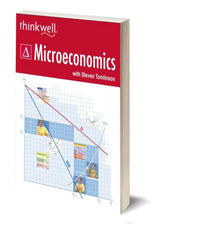
Honors Microeconomics Online Course
$169.00
Thinkwell's Honors Microeconomics
Thinkwell's Honors Microeconomics is a college-level course taught by Professor Steven Tomlinson, one of America's most talented professors. It's a fantastic way to learn about the complicated exchanges of goods and services that we deal with every day. Thinkwell's Honors Microeconomics follows a syllabus typically taught in a one-semester college-level course.
Combined with Honors Macroeconomics, Honors Microeconomics completes a one-year curriculum. Our Honors Economics course is simply a combination of both Honors Microeconomics and Honors Macroeconomics. No textbook required!
The Printed Notes (optional) are the Honors Microeconomics course notes from the Online Subscription printed in color, on-the-go format.





